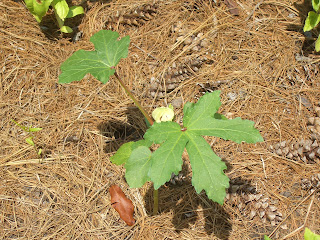Radio Interview: 107.7 FM Jamz Sunday, June 5th 2011, 11:00 AM
Public Appearance: CCP Meeting at the Bordeaux Library Saturday, June 18 2011, 2:00 PM
3711 Village Drive Fayetteville, NC 28304
The plants being discussed today are a pair I often refer to as 'Brothers in Arms' and no that's not Cacao and Marijuana, in fact it's a pair far more common and overlooked. Cotton and Okra have been a part of American agriculture for quite some time but their origins in agriculture go even further back. No two plants have been so deeply entwined in a social revolution, two wars and a slave trade that demolished a portion of the world population. Both Cotton and Okra are in the Malvaceae family which is more commonly known as the Mallow or Hibiscus family. If there was any doubt of the fact one need only see the flowers of either and all doubts are cast aside.
Malvaceae Abelmoschus esculentus - Okra
It is surprisingly rare how few people know the actual originating country of Okra, as this is not a well circulated bit of information. Okra originates from Africa, the very name 'Okra' is a perversion of one of the original names for this agricultural favorite. Some of the original names for it are Ocro, Guiabo, Guimgombo, ngombo and, Nkru. Ngombo was found to be from the Bantu language southern Africa. The word Nkru in respect was found to come from the Ashanti Language of western Africa. The cultivation of okra was developed enough to have become a major staple of Egypt for centuries before it was spread to the far East and the European nations and finally the Americas. In a medicinal light Okra is noted to have been used as a means of abortion by African slaves to prevent their children from being forced to live under slavery.
Malvaceae Gossypium hirsutum 'Nankeen' - Nankeen Cotton
Cotton in respects was a wide spread plant grown in several differing continents and climates but one the original varieties brought to the Americas Gossypium herbaceum is thought to have been originally cultivated in Ethiopia or southern Arabia. Cotton was a major product of the southern American economy and became economically important with the mechanization of the industry and the rise and expansion of slave labor in the Americas.
The interesting thing about Cotton is that during the American slave trade, slaves were prohibited from growing white cotton for themselves. Since white cotton was the major economic export the slave owners plainly wanted to sell as much agricultural product as was possible. The end result was that slaves were allowed to grow assorted colored varieties such as Nankeen, Mississippi brown and brown lint type cotton* this disparity in which cotton to grow became a symbol of the slave trade in America. When it comes to the harvesting of cotton few realize how much effort it takes. Typically the Cotton bolls are easy enough to identify, but the plants tended to bear them low. The actual pods from which the cotton fiber bursts often were hardened off sharp and dangerous to the unwary picker. If one were to add in the heat of the southern sun and the humid weather during harvest time harvesting cotton could be likened to a sampling of hell. Finally it is important to note that on the medicinal front, some slaves were known to make a tonic of sorts from the root of G. herbaceum in the attempt to cause an abortion no doubt for the exact reason noted above in the information for Okra. The harvesting of Cotton may be one of the experiences that a lot of gardeners could use if only to get a feel for the weight of the history. When I say Okra and Cotton are brothers in arms they may as well be, they are related, and they have become opposite sides of a proverbial coin upon which an entire nation's future rested.
I must admit, the aforementioned is unusually dark by LITFM standards but American history is full of such things, even in the field of agriculture there are unpleasant things that get buried in the progress of the years. Now for those still wishing to grow Okra and Cotton here is how you grow each. Both Cotton and Okra are easy to grow, they require a well drained soil and can tolerate a variety of nutrient issues and soil structure problems. Okra is more tolerant of poor soil whereas Cotton is a heavy feeder and will require fertilizer in most cases. The one thing neither will tolerate is being constantly wet, both get root or stem rot very rapidly if they are kept too wet. Both plants are transplant-sensitive and may appear to stop growing briefly when transplanted, the truth is both plants generally establish heavy networks of roots and their top growth often lags behind. Cotton is an attractive plant once mature as it forms a dense shrubby habit and it's mature leaves are glossy lobed and resemble giant Ivy leaves. The flower of cotton varies in color based on species but it is always quite pretty and large in typical mallow fashion. Okra is a strictly upright plant with a conical shape, depending on variety and climate it's height generally tops off at about six feet. Okra typically has deeply lobed leaves and some heritage varieties come in hues of yellow, orange and red tones. Okra flowers are no less attractive then cotton flowers with the exception that they seem to only come in a cheery butter-yellow. The general time from flower to okra pod is usually about three days and okra pods ten to be ready for picking in less then a week after the flower fades.
*The Southern Exposure Catalog has a excellent variety of natural colored cotton.


No comments:
Post a Comment